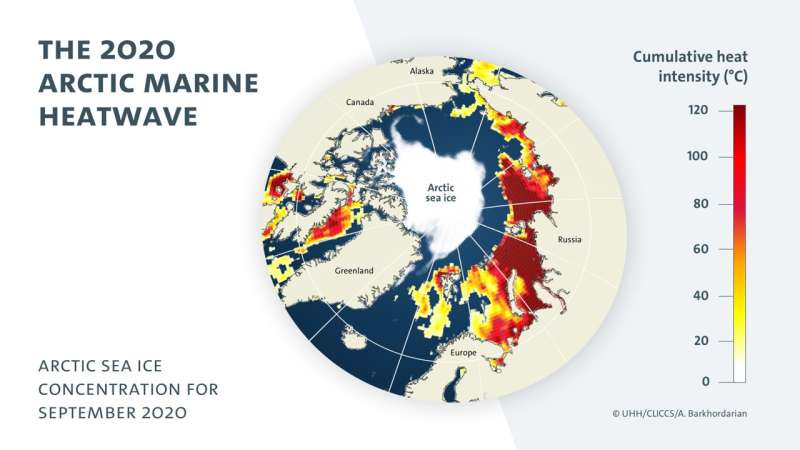Frequent marine heat waves in the Arctic Ocean will be the norm, says new study
Marine heat waves will become a regular occurrence in the Arctic in the near future and are a product of higher anthropogenic greenhouse-gas emissions, according to a study just released by Dr. Armineh Barkhordarian from Universität Hamburg’s Cluster of Excellence for climate research CLICCS.
Since 2007, conditions in the Arctic have shifted, as confirmed by data recently published in the journal Communications Earth & Environment. Between 2007 and 2021, the marginal zones of the Arctic Ocean experienced 11 marine heat waves, producing an average temperature rise of 2.2 degrees Celsius above seasonal norm and lasting an average of 37 days. Since 2015, there have been Arctic marine heat waves every year.
The most powerful heat wave to date in the Arctic Ocean was in 2020; it continued for 103 days, with peak temperatures that were four degrees Celsius over the long-term average. The probability of such a heat wave occurring without the influence of anthropogenic greenhouse gases is less than 1%, as calculated by Barkhordarian’s team at the Cluster of Excellence CLICCS. By doing so, they have narrowed down the number of plausible climate scenarios in the Arctic. According to the study, annual marine heat waves will be the norm.
The Arctic entered a new phase
In the study, Barkhordarian also proves for the first time that heat waves are produced when sea ice melts early and rapidly after the winter. When this happens, considerable heat energy can accumulate in the water by the time maximum solar radiation is reached in July.
“In 2007, a new phase began in the Arctic,” says Barkhordarian, an expert on climate statistics. “There is less and less of the thicker, several-year-old ice, while the percentage of thin, seasonal ice is consistently increasing.” However, the thin ice is less durable and melts more quickly, allowing incoming solar radiation to warm the water’s surface.
Officially, it is considered to be a marine heat wave when temperatures at the water’s surface are higher than 95% of the values from the past 30 years for at least five consecutive days.
“Not just the constant loss of sea ice but also warmer waters can have dramatic negative effects on the Arctic ecosystem,” says Barkhordarian. Food chains could collapse, fish stocks could be reduced, and overall biodiversity could decline.
More information:
Arctic marine heatwaves forced by greenhouse gases and triggered by abrupt sea-ice melt, Communications Earth & Environment (2024). DOI: 10.1038/s43247-024-01215-y
Citation:
Frequent marine heat waves in the Arctic Ocean will be the norm, says new study (2024, February 6)
retrieved 6 February 2024
from https://phys.org/news/2024-02-frequent-marine-arctic-ocean-norm.html
This document is subject to copyright. Apart from any fair dealing for the purpose of private study or research, no
part may be reproduced without the written permission. The content is provided for information purposes only.

Marine heat waves will become a regular occurrence in the Arctic in the near future and are a product of higher anthropogenic greenhouse-gas emissions, according to a study just released by Dr. Armineh Barkhordarian from Universität Hamburg’s Cluster of Excellence for climate research CLICCS.
Since 2007, conditions in the Arctic have shifted, as confirmed by data recently published in the journal Communications Earth & Environment. Between 2007 and 2021, the marginal zones of the Arctic Ocean experienced 11 marine heat waves, producing an average temperature rise of 2.2 degrees Celsius above seasonal norm and lasting an average of 37 days. Since 2015, there have been Arctic marine heat waves every year.
The most powerful heat wave to date in the Arctic Ocean was in 2020; it continued for 103 days, with peak temperatures that were four degrees Celsius over the long-term average. The probability of such a heat wave occurring without the influence of anthropogenic greenhouse gases is less than 1%, as calculated by Barkhordarian’s team at the Cluster of Excellence CLICCS. By doing so, they have narrowed down the number of plausible climate scenarios in the Arctic. According to the study, annual marine heat waves will be the norm.
The Arctic entered a new phase
In the study, Barkhordarian also proves for the first time that heat waves are produced when sea ice melts early and rapidly after the winter. When this happens, considerable heat energy can accumulate in the water by the time maximum solar radiation is reached in July.
“In 2007, a new phase began in the Arctic,” says Barkhordarian, an expert on climate statistics. “There is less and less of the thicker, several-year-old ice, while the percentage of thin, seasonal ice is consistently increasing.” However, the thin ice is less durable and melts more quickly, allowing incoming solar radiation to warm the water’s surface.
Officially, it is considered to be a marine heat wave when temperatures at the water’s surface are higher than 95% of the values from the past 30 years for at least five consecutive days.
“Not just the constant loss of sea ice but also warmer waters can have dramatic negative effects on the Arctic ecosystem,” says Barkhordarian. Food chains could collapse, fish stocks could be reduced, and overall biodiversity could decline.
More information:
Arctic marine heatwaves forced by greenhouse gases and triggered by abrupt sea-ice melt, Communications Earth & Environment (2024). DOI: 10.1038/s43247-024-01215-y
Citation:
Frequent marine heat waves in the Arctic Ocean will be the norm, says new study (2024, February 6)
retrieved 6 February 2024
from https://phys.org/news/2024-02-frequent-marine-arctic-ocean-norm.html
This document is subject to copyright. Apart from any fair dealing for the purpose of private study or research, no
part may be reproduced without the written permission. The content is provided for information purposes only.
